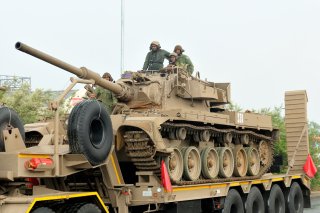South Africa's Cold War-era Olifant Tank Is the Best in Africa
Unless you’re a hardcore student of military history and international relations alike, chances are you might not realize that South Africa also has its own homegrown main battle tank that is still going strong after all these decades.
When one thinks of Cold War-era main battle tanks that remain in service in the present day, chances are the American-made M1 Abrams comes immediately to mind, along with the Russian-made T-72, the British-built Challenger, and Israel’s homegrown Merkava. But unless you’re a hardcore student of military history and international relations alike, chances are you might not realize that South Africa also has its own homegrown MBT that is still going strong after all these decades.
Say hello (or “Sawubona” if you’re Zulu; “Goie Middag” if you’re an Afrikaner) to the Olifant (“Elephant”), the MBT of the South African National Defence Force (SANDF) and arguably the best indigenous tank design in the history of the African continent.
Olifant Initial History and Specifications
The Olifant debuted in 1976, starting off with the Mk. 1 variant that was based upon the aforementioned British Challenger, but it was redesigned and rebuilt by South Africa with a wee bit of help from Israel.
Specifications and vital stats of the Olifant included:
· Crew: four (commander, gunner, loader, driver)
· Weight: 58 tons
· Length: 7.557 meters (24 feet 9.5 inches) when measuring hull only; 9.83 meters (32 feet 3 inches) when factoring in gun forward
· Height: 2.94 meters (9 feet 7.75 inches)
· Armor Thickness: 51-152 mm (2.0-6.0 inches)
· Max Speed:
o Mk. 1 variant: 34.6 km/h (21.5 mph)
o Mk. 1A, Mk. 1B, Mk. 2 variants: 56 km/h (35 mph)
· Main Armament:
o Mk. 1: Ordnance QF 20 pounder 84mm (3.307 inch) gun
o Later variants: Royal Ordnance L7 105mm rifled gun
· Secondary Armament: Coaxial .30 caliber (7.62x63mm machine gun)
A total of 224 Olifants of all variants combined have been produced by Olifant Manufacturing Co. and its successor corporation, Land Systems OMC.
Olifant Operational History and Combat Performance (in a Former Colleagues’ Own Words)
My “boet” (that’s Afrikaans for “bud”) “Grunt” (a pseudonym, obviously), with whom I worked as a security contractor at Balad Airbase, Iraq, from 2015 to 2018—and whom some of you dear readers may recall as one of my interview subjects for my December 2024 article on South Africa’s elite Parachute Battalion (aka, the “Parabats”)—was generous enough to give me his firsthand perspective as a former Olifant crewman in the SANDF. “Grunt’s” assignments included the School of Armour and a commando unit thereafter, starting off his military career as a conscript and rising up the ranks to troop sergeant before gaining accession to the commissioned officer ranks, ultimately leaving the service with the rank of “Lieutenant qualified to Major.” Here’s what “Grunt” had to say about the Olifant and its effectiveness in combat:
“With its 105mm L7 gun, it was a formidable opponent to the 100mm T-55 and T-54 Soviet tanks where they met on the battlefield of Angola. SADF [the Cold War iteration of the SANDF] adapted the tank and tactics to suit the Bush War where the tanks were used in Operation Modular Hooper and Packer from late 1987 to 1988 along the Lomba River and later [in] the Battle of Cuito Canavale. With superior tactics and a strong rear echelon, the South Africans pushed forward, and these tanks inflicted heavy casualties on their opposition [even though] South Africans had not seen tank-to-tank battle since World War II.”
Baie dankie (“Thank you very much”) for that, “Grunt!”
Where Are They Now?
The current iteration is the Mk. 2. According to Army Recognition, it has two improvements over the original: a 25 percent faster acceleration thanks to an improved power-to-weight ratio which increased from 14.4 horsepower per ton to 17.19 horsepower per ton.
Only twenty-six specimens of this newer “Elephant” have been built thus far, as the SANDF decided to allocate more of its budget toward upgrading the older iterations.
About the Author: Christian D. Orr
Christian D. Orr is a Senior Defense Editor for National Security Journal (NSJ). He is a former Air Force Security Forces officer, Federal law enforcement officer, and private military contractor (with assignments worked in Iraq, the United Arab Emirates, Kosovo, Japan, Germany, and the Pentagon). Chris holds a B.A. in International Relations from the University of Southern California (USC) and an M.A. in Intelligence Studies (concentration in Terrorism Studies) from American Military University (AMU). He has also been published in The Daily Torch, The Journal of Intelligence and Cyber Security, and Simple Flying. Last but not least, he is a Companion of the Order of the Naval Order of the United States (NOUS). If you’d like to pick his brain further, you can ofttimes find him at the Old Virginia Tobacco Company (OVTC) lounge in Manassas, Virginia, partaking of fine stogies and good quality human camaraderie.
Image: Grobler du Preez / Shutterstock.com

